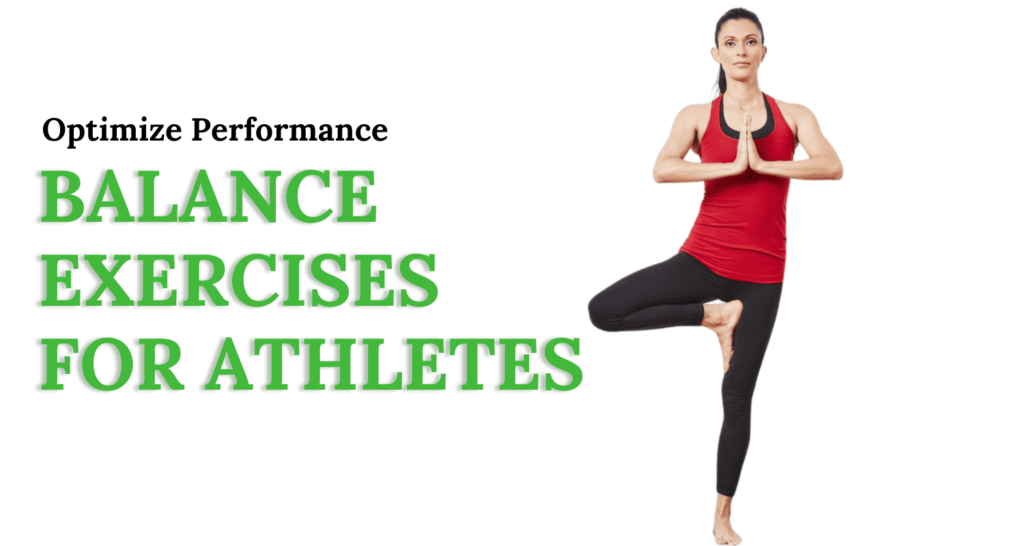Did you know that balance is a key factor in an athlete’s performance?
It’s not just about strength and speed; having good balance can greatly impact an athlete’s stability, coordination, and overall athletic ability.
In this article, we will explore the importance of balance exercises for athletes and how specific exercises can enhance their performance and enhance sports balance drills.
Let’s explore balance exercises for athletes.
Key Takeaways:
- Balance is a crucial aspect of an athlete’s performance.
- Good athlete balance training enhances stability, coordination, and overall ability.
- Specific balance exercises for athletes can optimize their performance.
- Incorporating balance exercises for athletes into their training routine is essential.
- By improving their balance through score stability exercises for athletes, they can elevate their game to new heights.
Core Stability Exercises for Athletes
When it comes to athletic performance, core stability is a game-changer.
A strong and stable core not only enhances an athlete’s balance and coordination but also improves their overall performance on the field.
Incorporating specific core stability exercises into an athlete’s training routine can help them maintain control and stability during dynamic movements.
Here are some effective core stability exercises that athletes can incorporate into their workouts for performance enhancements:
- Plank: This classic exercise is perfect for building core strength and stability. Start in a push-up position, supporting your body weight on your forearms and toes. Keep your body in a straight line and hold for a specific time.
- Medicine Ball Russian Twist: Sit on the floor with your knees bent and feet flat on the ground. Hold a medicine ball or weight in front of your chest. Twist your torso to one side, bringing the ball or weight beside your hip. Return to the starting position and repeat on the other side.
- Dead Bug: Lie on your back with your arms extended towards the ceiling, and your knees bent at a 90-degree angle. Slowly lower one arm above your head while simultaneously straightening the opposite leg. Return to the starting position and repeat on the other side.
- Bird Dog: Begin on all fours, with your hands directly below your shoulders and your knees below your hips. Extend your right arm forward and your left leg backward, keeping your back straight. Hold for a moment and then switch sides.
These core stability exercises target the deep muscles of the abdomen, back, and pelvis, helping athletes improve their balance and coordination.
Incorporating them into your training routine can lead to enhanced stability and agility, ultimately boosting your overall athletic performance.
Dynamic Balance Workouts for Athletes
Dynamic balance is crucial for athletes who need to perform rapid and agile movements on the field.
It is the key to changing direction swiftly and maintaining stability during sports-specific activities.
To enhance an athlete’s dynamic balance, a range of workouts and agility exercises can be incorporated into their training regimen.
Plyometric Drills
Plyometric exercises focus on explosive movements and quick transitions.
They help athletes build dynamic balance by improving their ability to absorb forces and rapidly change direction. Some popular plyometric exercises include:
- Box Jumps: Athletes jump onto a box or platform, then quickly step down and repeat.
- Lateral Bounds: Athletes jump laterally from side to side, emphasizing dynamic balance and power.
- Depth Jumps: Athletes step off a raised platform, then explode into a vertical jump upon landing.
Agility Ladder Drills
Agility ladder drills are excellent for improving footwork, coordination, and balance.
Athletes perform a series of quick and precise movements through the agility exercises for sports ladder, challenging their dynamic balance. Some effective agility ladder drills include:
- Two-Feet In/Out: Athletes step in and out of ladder squares with both feet, maintaining a fast pace.
- Lateral Quick Steps: Athletes move laterally along the ladder, alternating their feet in each square.
- Single-Leg Hops: Athletes hop on one leg, moving forward or laterally through the ladder.
Bosu Ball Exercises
Utilizing a Bosu ball for workouts can provide an unstable surface, challenging an athlete’s balance and stability.
Some beneficial Bosu ball exercises include:
- Bosu Ball Squats: Athletes stand on the Bosu ball and perform squats, engaging their core and lower body for dynamic balance.
- Bosu Mountain Climbers: Athletes assume a push-up position with their hands on the Bosu ball, then bring their knees towards their chest in a dynamic, alternating fashion.
- Bosu Ball Plyo Push-ups: Athletes perform push-ups with their hands on the Bosu ball, incorporating explosive movements to challenge their dynamic balance.
By incorporating these dynamic balance workouts and agility exercises into their training routine, athletes can enhance their ability to perform quick movements, change direction effectively, and maintain balance during sports-specific activities.
Practicing these exercises regularly will yield improvements in overall athletic performance.
Proprioceptive Training for Athletes
Proprioception is a fundamental aspect of an athlete’s performance, allowing them to have a keen sense of their body’s position in space.
Incorporating proprioceptive training into an athlete’s regimen can significantly enhance their balance, stability, and overall athletic ability.
One key benefit of proprioceptive training is its ability to target specific muscle groups that play a vital role in maintaining balance and stability.
By engaging these muscles through a variety of exercises, athletes can improve their body’s awareness and control, leading to better proprioception.
When it comes to stability exercises for athletes, there is a wide range of options available.
Here are some effective proprioceptive exercises:
- Single-leg balance: Stand on one leg while maintaining proper posture and balance. This exercise helps strengthen the muscles involved in ankle stability and improves overall proprioception.
- Bosu ball exercises: Utilize a Bosu ball, which is a half-sphere platform, to challenge balance and stability. Perform exercises such as squats or lunges on the Bosu ball’s unstable surface to engage the proprioceptive system.
- Balance board exercises: Use a balance board or wobble board to create an unstable surface for various exercises. These exercises target the muscles in the feet, ankles, and lower legs, enhancing proprioception and stability.
- Resistance band exercises: Incorporate resistance bands into exercises like lateral walks or monster walks to add an element of instability. This challenges the athlete’s body control and proprioceptive abilities.
By incorporating proprioceptive training into their routine, athletes can enhance their performance on the field, court, or track.
These stability exercises for athletes not only improve balance and stability but also help prevent injuries by strengthening the supportive muscles around joints.
Strength and Balance Training for Athletes
In order to optimize their performance, athletes must focus on both strength and balance.
By combining balance and coordination exercises training with specific strength exercises, athletes can improve their overall stability, power, and control during sports movements.
A key aspect of strength and balance training is targeting the core muscles.
The core acts as the body’s stabilizer, providing a solid foundation for all movements.
Including exercises that engage the core will enhance an athlete’s ability to maintain balance in various athletic positions.
One effective exercise for core strength and balance is the plank.
This exercise engages multiple muscle groups, including the abdominals, lower back, and hips.
To perform a plank, start in a push-up position, but with your elbows on the ground. Maintain a straight line from your head to your heels, engaging your core muscles.
Hold this position for a specified amount of time, gradually increasing the duration as you build strength.
Another key component of strength and balance training is targeting the lower body muscles.
Exercises like squats and lunges help develop strength and stability in the legs, which are essential for maintaining balance in dynamic movements.
Adding a balance element to these exercises can further enhance an athlete’s performance.
For example, performing a single-leg squat or a single-leg balance reach challenges stability and improves coordination.
Strength and balance training should also include exercises that address other muscle groups, such as the upper body and back.
By maintaining a balanced approach to training, athletes can improve overall strength and stability, reducing the risk of injury during sports activities.
Sample exercises to include in strength and balance training:
1. Plank variations (e.g., side plank, plank with leg lift)
2. Squat variations (e.g., goblet squat, pistol squat)
3. Lunge variations (e.g., reverse lunge, lateral lunge)
4. Bosu ball exercises (e.g., single-leg balance, push-ups on the Bosu ball)
5. Resistance band exercises (e.g., rows, bicep curls)
By incorporating strength and balance training into their regular workout routines, athletes can improve their overall athletic ability, performance, and reduce the risk of injury.
Balancing exercises for athletes provide a solid foundation for them to excel in their respective sports and reach their full potential.
Conclusion
Incorporating balance exercises for athletes into their training routine is crucial for optimizing performance.
By focusing on core stability exercises, dynamic balance workouts, proprioceptive training, and strength and balance training, athletes can enhance their stability, coordination, and overall athletic ability.
Core stability exercises improve balance and coordination, helping athletes maintain control and stability during dynamic movements.
Dynamic balance workouts and agility exercises enhance an athlete’s ability to change direction and maintain balance during sports-specific activities.
Proprioceptive training targets specific muscle groups and enhances the body’s awareness and control, improving balance and stability.
Strength and balance training combine to improve overall stability, power, and control in sports movements.
So, whether you’re a professional athlete or a weekend warrior, it’s time to start incorporating these balance exercises into your training regimen.
Elevate your game to new heights by improving your stability, coordination, and overall athletic ability.
Don’t underestimate the impact that balance training can have on your performance.
Take the first step towards becoming a stronger, more agile athlete today!
FAQs
What are some balance exercises for athletes?
Some balance exercises for athletes include single-leg stands, heel-to-toe walks, and balancing on unstable surfaces like foam pads or inflatable discs. These exercises help improve stability and proprioception.
How do athletes train balance?
Athletes train balance through specific exercises focusing on stability, coordination, and proprioception, often incorporating equipment like balance boards or bosu balls.
What exercise is best for balance?
Balance exercises for athletes such as single-leg squats, yoga poses like tree pose, and dynamic movements like lateral lunges are effective for enhancing balance.
What are the 3 types of balance exercises?
The three types of balance exercises for athletes include static balance exercises (e.g., standing on one leg), dynamic balance exercises (e.g., walking heel to toe), and proprioception exercises (e.g., using balance boards).
What is the best sport for balance?
Gymnastics, martial arts, and snowboarding are among the sports known to require exceptional balance due to their dynamic and demanding nature.
What is balance in athletics?
Balance in athletics refers to the ability to maintain control of one’s body position while performing various movements or actions, crucial for agility, coordination, and injury prevention.
How can an athlete gain more balance?
Athletes can improve balance through consistent practice of balance-specific exercises, incorporating strength training, flexibility work, and proprioceptive drills into their training regimen.
Disclaimer: This content, including advice, provides generic information only. It is not a substitute for a qualified medical opinion. Always consult a specialist or your doctor for more information. Nutrition Cult does not claim responsibility for this information.




